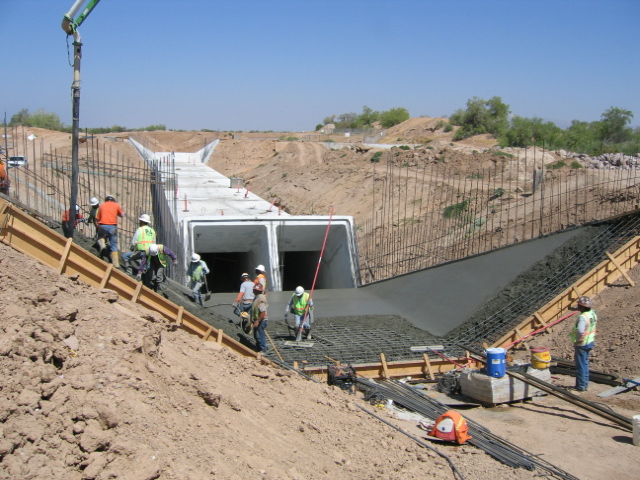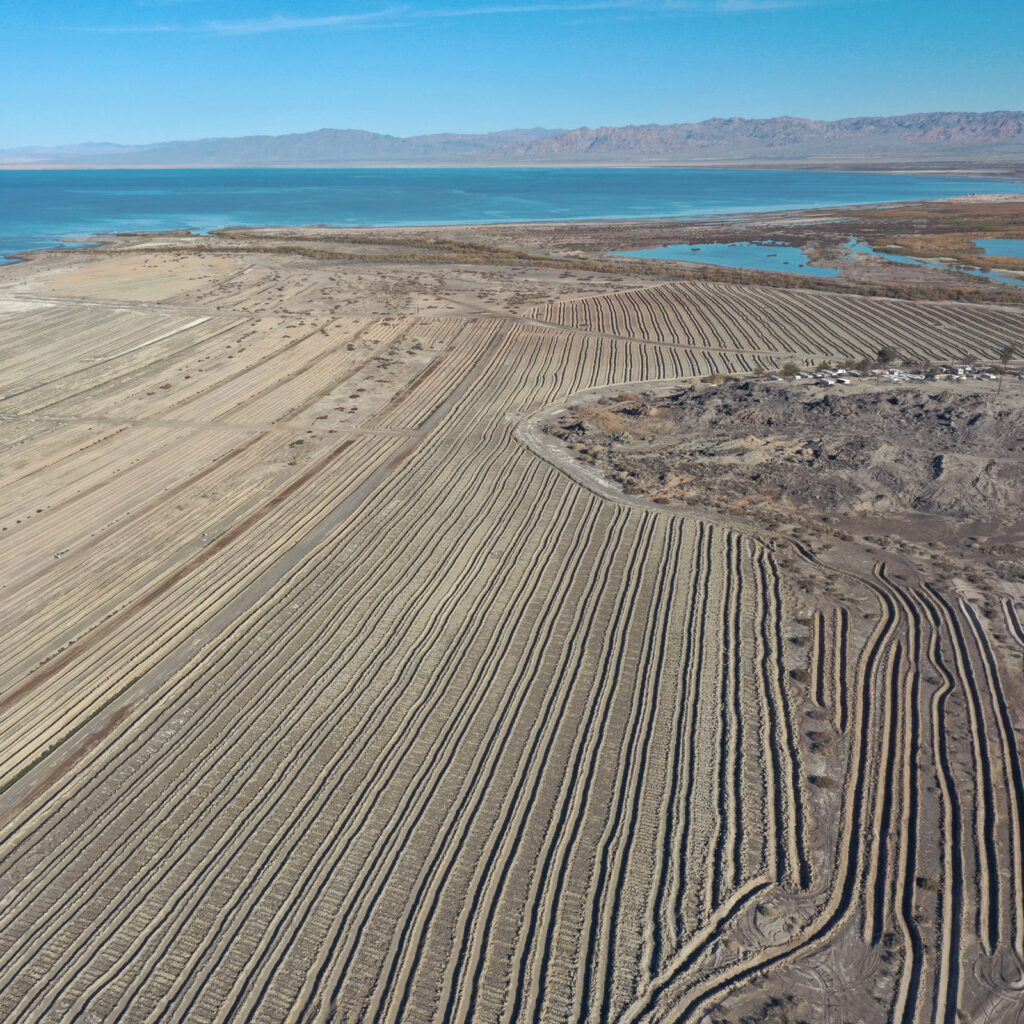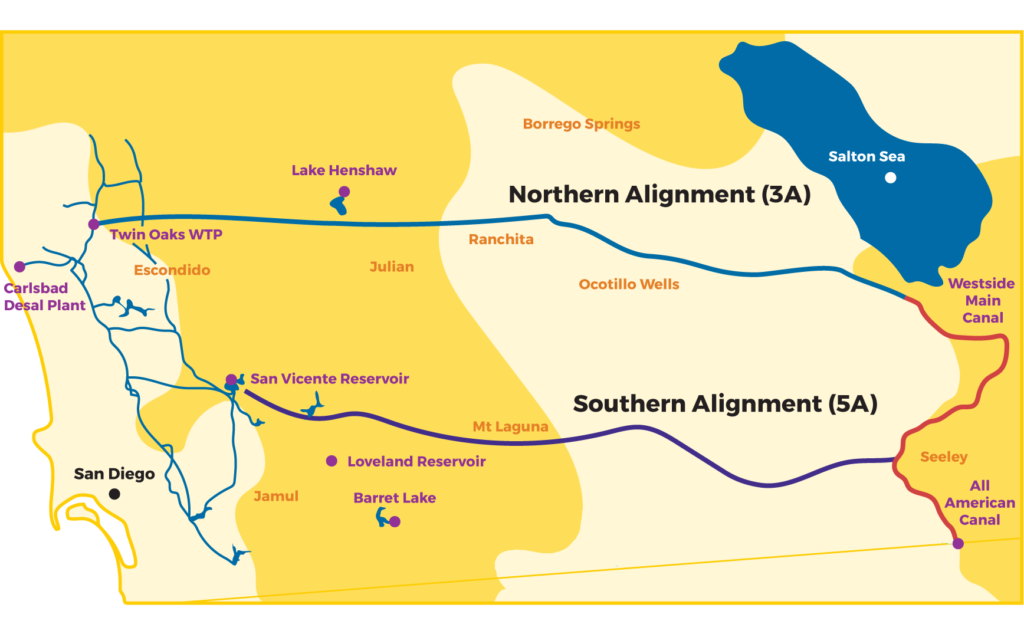
Colorado River Provides Highly Reliable Supplies
The Water Authority’s supply portfolio includes senior-priority, independent conserved Colorado River supplies negotiated through the landmark 2003 Quantification Settlement Agreement, or QSA. These conserved supplies are the cornerstone of the San Diego region’s long-term water supply diversification strategy. In addition, the Water Authority purchases Colorado River water from the Metropolitan Water District of Southern California (MWD).
Before 2003, the Water Authority purchased its imported water supply from MWD, which owns and operates the 240-mile-long Colorado River Aqueduct. Implementing the Water Authority’s diversification strategy, rather than relying on a single supplier, has ensured water resiliency for the region.
A Water Gateway
By developing large, independent supplies from the Colorado River, the Water Authority enhanced water reliability. The QSA supplies include 200,000 acre-feet annually through the conserved water transfer agreement with the Imperial Irrigation District and 77,700 acre-feet conserved by concrete lining long stretches of the All-American and Coachella canals. These conserved QSA supplies benefit the San Diego County region while protecting agriculture and the environment.
They also provide an example of collaboration on the river. The Water Authority continues to collaborate with a diverse group of stakeholders on Colorado River issues and water management strategies that would provide flexibility and benefits to the region and the entire Basin.

Colorado River Quantification Settlement Agreement
In October 2003, the San Diego County Water Authority, Coachella Valley Water District, Imperial Irrigation District, Metropolitan Water District of Southern California, State of California and U.S. Department of the Interior completed a historic set of agreements to conserve and transfer Colorado River water.
The San Diego County Water Authority sits on the QSA Joint Powers Authority, the governing board formed under 2003 QSA-related legislation to administer funding of environmental mitigation requirements related to the QSA water transfers. For more information about the QSA JPA, go to QSAJPA.org.
Key Benefits
Known as the Colorado River Quantification Settlement Agreement, or QSA, the agreements settled decades of dispute over Colorado River water. The QSA has held up to scrutiny under several unsuccessful legal challenges in state and federal courts.
Helps California Manage its Colorado River Supply
The QSA enables California to live within its historic 4.4 million acre-feet annual river apportionment through a series of agreements that focus on conservation to generate water while protecting the environment and agriculture. The QSA has served as a tool to aid the Department of the Interior in managing the river.
Addresses the Salton Sea
The Quantification Settlement Agreement Joint Powers Authority (QSA JPA) was formed under 2003 legislation to administer funding of environmental mitigation requirements related to the QSA water transfers. Separately, legislation made the state solely responsible for the larger issue of Salton Sea restoration. The state is implementing a phased approach to restoration in the form of its Salton Sea Management Program. There is over $400 million available in state funding for restoration and efforts are underway to secure additional funding for the program.
Provides Water
The QSA provides more than 30 million acre-feet of high-priority, conserved water to the San Diego region over the life of the agreements.
Fosters Mutual Benefits
QSA funds support conservation, economic diversification, agricultural growth, environmental mitigation, and protection of long-standing water rights. The QSA also serves as a model for collaboration and conservation on the river.

Conserved Water Transfer Agreement
As part of the QSA, the Water Authority-Imperial Irrigation District (IID) conserved water transfer agreement provides 200,000 acre-feet of water a year for the San Diego region through water conservation measures in Imperial Valley. It is the largest agriculture to urban water transfer in the nation.
Supported by annual funding from the Water Authority, IID conserves through a combination of system conservation and on-farm conservation methods. In 2010, the Water Authority also provided IID with $50 million to assist in these efforts. IID is using that $50 million for the exclusive purpose of constructing system-conservation capital improvement projects. Between 2003 and 2017, the Water Authority also provided $30 million to IID to help diversify the Imperial Valley economy and mitigate socioeconomic impacts of the water transfer.
The initial term of the Water Authority-IID conserved water transfer agreement runs through 2047. If both parties agree, the agreement can be renewed through 2077.
 Conserved Water Transfer Agreement Fact Sheet
Conserved Water Transfer Agreement Fact Sheet
Agreement Highlights
The conserved water transfer agreement has become a critical part of the Water Authority’s diversification strategy, implemented to better serve its member agencies. Through this agreement, the San Diego region has gained a highly reliable, water supply to serve generations to come. The transfer shields the region from the worst effects of drought and supports the incremental development of additional local supplies such as reuse projects.
Agency Roles
IID is responsible for implementing efficiency-based conservation to produce the Water Authority’s conserved transfer water. MWD takes delivery of the Water Authority’s transfer water at Lake Havasu and delivers the water to the Water Authority’s service area through the Colorado River Aqueduct.
Transfer Water Pricing
Through 2034, the price of the transfer water will be based on the annual increase in the Gross Domestic Product Implicit Price Deflator published by the Bureau of Economic Analysis of the U.S. Department of Commerce. Beginning in 2035, either the Water Authority or IID can, if certain criteria are met, elect to set a market price through a formula described in the conserved water transfer agreement. In addition, a shortage premium price can be imposed under certain conditions after 2035.
JPA & Environmental Mitigation Funds
The QSA Joint Powers Authority (JPA) was established in 2003 to collect, hold, invest, and disburse the funds necessary for environmental mitigation required for the Water Authority’s and Coachella Valley Water District’s (CVWD) conserved water transfers with IID. The governing body of the QSA JPA is a commission of four members, including one representative from the state’s Department of Fish and Wildlife, who chairs the commission, and one member each from the Water Authority, CVWD, and IID. The Water Authority is responsible for administering the QSA JPA.
QSA Supplies Data
Recorded and projected data of the conserved water transfer agreement and conserved water received from the canal lining projects..


Conserved Water Received Through Canal Lining Projects
The All-American and Coachella Canal lining projects are critical components of the QSA, providing 77,700 acre-feet a year of conserved canal water to the San Diego region through 2112. Over the term of the agreement, 8.5 million acre-feet will flow to the San Diego County region. Additionally, 16,000 acre-feet of conserved water per year from the projects is sent to several bands of Mission Indians in northern San Diego County, settling a water rights dispute and decades of litigation with the federal government. The Water Authority funded the canal lining projects with assistance from the state.
The 82-mile All-American Canal, located in the southeastern corner of California, conveys water from the Colorado River to California’s Imperial Valley. The 123-mile Coachella Canal is a branch of the All-American Canal that delivers water to California’s Coachella Valley.























Project Highlights
Water Conserved by Concrete Lining
Recognizing the importance of water conservation, the Water Authority invested in the concrete lining of two major canals with assistance from the state. After the QSA was signed in 2003, approximately 23 miles of concrete-lined parallel canal was constructed next to the original All-American Canal, and 35 miles of concrete-lined parallel canal, the last unlined segment, was constructed next to the original Coachella Canal. Water flows were then diverted into the concrete-lined sections, significantly reducing seepage through the earthen canals, and allowing conserved water to be used.
Annual Water Flow
The Coachella Canal Lining Project was completed in 2007, when 26,000 acre-feet per year of conserved water began flowing to project beneficiaries. The All-American Canal Lining Project was completed in 2010, when its full yield of 67,700 acre-feet per year was made available.
Environmental Mitigation
The canal lining projects required extensive environmental mitigation, some of which is ongoing. As part of the fishery mitigation requirement, fish were relocated from the canal systems into nearby lakes prior to construction, and a 50-acre fishpond was constructed on the Wister Waterfowl Management Area that is owned by the California Department of Fish and Wildlife.
Additionally, 17 acres of marsh were constructed in the Dos Palmas Area of Critical Environmental Concern, providing new habitat for wildlife. Ongoing mitigation efforts include upgrading the water supply system, maintaining, and monitoring various habitats in Dos Palmas Oasis, and restoring 352 acres of desert riparian habitat.


Salton Sea
The Salton Sea is the largest lake in California, covering about 375 square miles of Imperial and Riverside counties. It is in the Salton Basin, which from the earliest documented history has periodically filled with water, most notably ancient Lake Cahuilla.
In its current form, the Salton Sea was created when a dike failed and the Colorado River flooded the basin in 1905. Since then, the sea has been fed mainly by agricultural runoff from the New and Alamo rivers (the New River starts in Mexico and flows through the Imperial Valley) and the Whitewater River in the Coachella Valley.
The Salton Sea provides habitat for a wide range of bird species, including migratory birds on the Pacific Flyway. Efforts by the Water Authority and partnering agencies (Coachella Valley Water District (CVWD) and Imperial Irrigation District (IID)), to provide funding for environmental mitigation under the QSA Joint Powers Authority (JPA), are a critical component of the sea’s future.























QSA Joint Powers Authority & Mitigation
The QSA JPA implements environmental mitigation to address the distinct impacts of the QSA, at the Salton Sea. QSA JPA mitigation efforts are separate but complementary to the state’s restoration efforts at the sea.
Funding Agreements
As part of the QSA JPA, the three water agencies committed to pay up to $133 million in 2003 dollars. Under state law, any mitigation expenses above $133 million are the unconditional responsibility of the State of California. Additionally, the Water Authority, IID, and CVWD agreed to pay $30 million in 2003 dollars as seed money to jumpstart the state’s restoration program. The Water Authority has fully paid its share of the restoration funding.
The Water Authority has met all of its financial commitments since 2003 and is in compliance with all state and federal environmental obligations.
Water Transfer Mitigation
From 2003 to 2017, the QSA JPA’s funding provided bucket-for-bucket mitigation water to the Salton Sea. Starting in 2018, the focus shifted to air quality projects.
Air Quality Projects
The QSA JPA has funded the placement of six air quality stations around the sea to monitor air quality, construction of a 950-acre managed marsh as new wildlife habitat, and a series of on-going air quality projects, such as surface roughening, vegetation enhancement, and habitat generated from groundwater, to protect human health.


Regional Conveyance System Study
The Water Authority has been studying the feasibility of building a water conveyance path from the Imperial Valley to the Water Authority’s service area as an alternative to using Metropolitan Water District’s Colorado River Aqueduct, for which the Water Authority pays a significant conveyance cost. Phase A of the study is complete. Phase B, which includes updating costs to reflect MWD’s latest rates as well as updating construction cost, is on hold during the 2024-25 budget period.














































Key Study Points
Current Conveyance System
The Water Authority currently pays the Metropolitan Water District of Southern California to transport Quantification Settlement Agreement conserved water from the Imperial Valley through the Colorado River Aqueduct to the San Diego region. This delivery agreement (Exchange Agreement) expires in 2047 for the water transfer but is in place for the entire 110-year term of the canal lining supplies’ agreement, through 2112. The current conserved water transfer agreement between the Imperial Irrigation District and the Water Authority continues to 2047 but both agencies can agree to extend the transfer another 30 years to 2077. The Water Authority is evaluating the most cost-effective way to convey this water beyond 2047 to help inform future water resource decisions.
Study Phase A – Engineering & Cost Analysis
The Phase A report is the result of a technical and cost analysis by Black & Veatch and the preliminary economic analysis by Water Authority staff. The engineering firm conducted similar studies as part of the Water Authority’s Regional Water Facilities Optimization and Master Plan Update, dating back to 1996, assessing “single use” water-delivery projects in those studies. The current analysis looks at a conveyance project with multiple partnership possibilities and potential regional benefits that align with the Governor’s Water Resilience Portfolio.
Three potential routes for the pipeline were considered as part of Phase A which focused on engineering analysis to update costs and identify any technical or financial fatal flaws. No fatal flaws were identified and two of the routes were deemed cost-competitive with other options.
Study Phase B – Funding & Partnership Assessment
Phase B of the study, currently on hold, would refine the Phase A technical analysis.
Reports & Documents
Water Authority Reports



















































































































Other Documents










































































































































Related Documents
































































































































































